Hollow core doors are a popular and affordable option for many homeowners. However, they can be prone to noise transmission and may not offer the best insulation.
If you want to reduce noise or improve insulation, you may wonder if you can fill a hollow core door with foam.
In this article, we’ll explore the topic of filling hollow core doors with foam and discuss whether it’s a viable solution for improving insulation and reducing noise.
We’ll also provide you with some tips and tricks to help you achieve the best possible results if you decide to take on this project.
What Is Spray Foam?
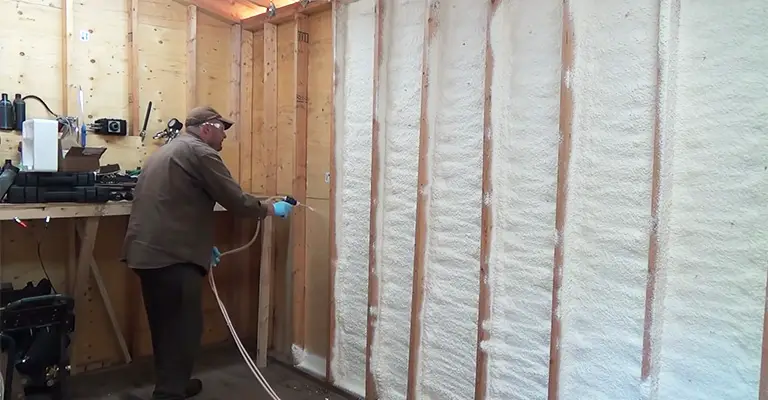
It is important to understand the functionality of spray polyurethane foam. This substance is a polymer that is activated by heat and is commonly used for foam insulation.
Its composition consists of two ingredients, isocyanate and polyol resin, which are mixed during the application process using a spray tube.
Upon reaction, the liquid mixture transforms into a foamy consistency, expands and ultimately solidifies, effectively insulating the desired surface and filling any cracks or gaps.
Why Is Spray Foam So Popular?
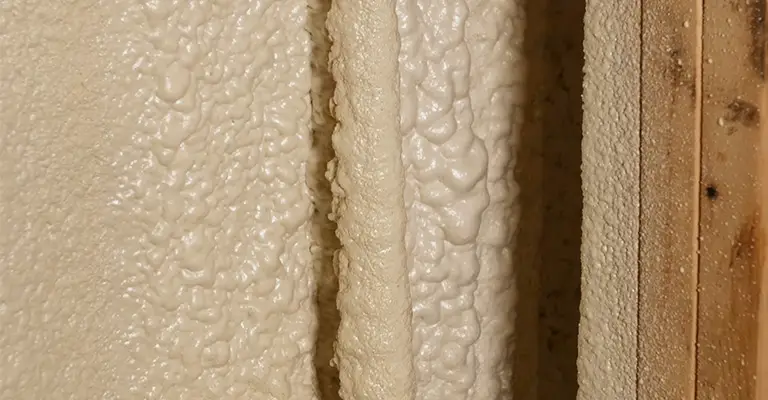
Spray foam has become a popular insulation method due to its excellent ability to seal air leaks. Once applied, it effectively fills cavities and small holes, making it an ideal solution for ensuring air tightness.
Additionally, it can be applied to both horizontal and vertical surfaces, serving as an efficient air barrier.
Since spray foam is a synthetic material, it is not attractive to pests such as insects or rodents. Moreover, if applied correctly, it can improve energy efficiency and reduce energy costs.
Can You Fill A Hollow Core Door With Foam?
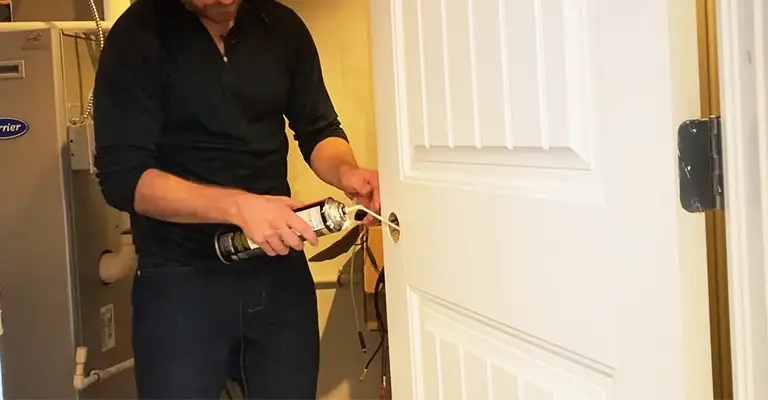
While not commonly discussed, it is possible to transform a hollow core door into a solid one by filling it with insulation foam. The process involves creating small holes along the edges of the door and filling them with foam.
To ensure proper filling, start from the bottom of the door and work your way up, spraying foam every 12 inches.
However, this process requires careful attention to detail and carries some risks that could damage the door beyond repair, ultimately requiring a replacement.
It is essential to note that the lock mechanism should be removed during this process to avoid any potential hardware damage.
Before attempting to fill your door with foam, it is crucial to fully understand the requirements and potential risks involved. Further information on this process will be provided below.
Are There Any Problems With Filling A Hollow Door With Foam?
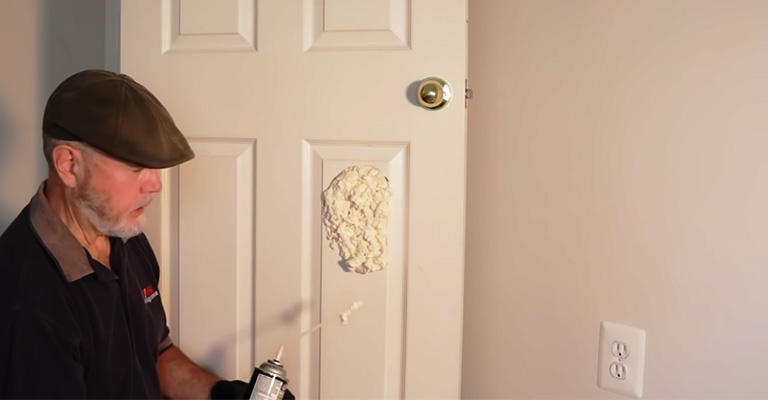
Filling a hollow door with foam may not be the best solution for several reasons. It is often recommended to replace the door instead of filling it with foam.
One reason is that hollow doors have an internal structure, usually consisting of cardboard support between the panels.
This structure, resembling a honeycomb, can make it difficult for the foam to spread evenly throughout, resulting in ineffective insulation.
Additionally, some types of doors, such as those made of Luan plywood, may not be suitable for foam filling, as the veneer is not thick enough to withstand the force of the expanding spray foam.
It is important to thoroughly understand the project and the process before attempting to fill a hollow door with foam.
Keep in mind that the spray foam requires a sufficient amount of atmospheric air to react properly and expand within the door.
This can be challenging to achieve with a door. In most cases, ordering a new insulated door is easier than attempting to fill a hollow one with foam.
What To Check Before Filling The Door With Foam?
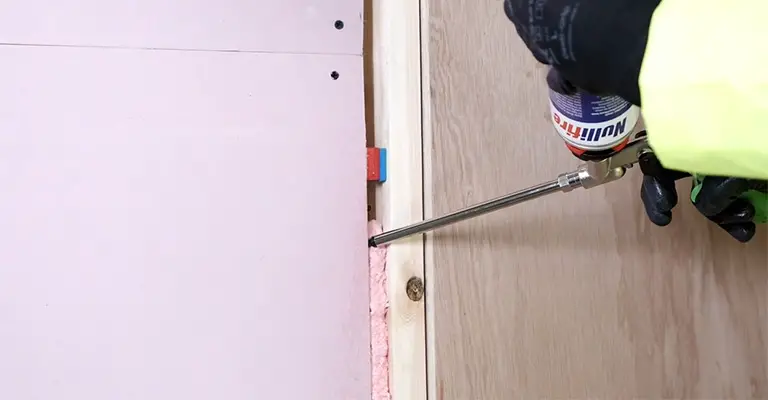
It is crucial to bear in mind that most hollow doors contain a honeycomb-like arrangement of cardboard inside. Therefore, it is possible that the foam may not be able to reach all areas inside the door.
As a precaution, it is advisable to drill a hole into the top edge of the door and use a flashlight to check the extent of the hollow space.
If the door is indeed hollow, it may be feasible to fill it with foam, but it is recommended to use a foam that expands less aggressively.
Additionally, it is crucial to prepare the area by placing newspapers or cardboard to avoid any mess created by the foam, which can be challenging to clean once it hardens.
How Can You Fill A Hollow Door With Foam?
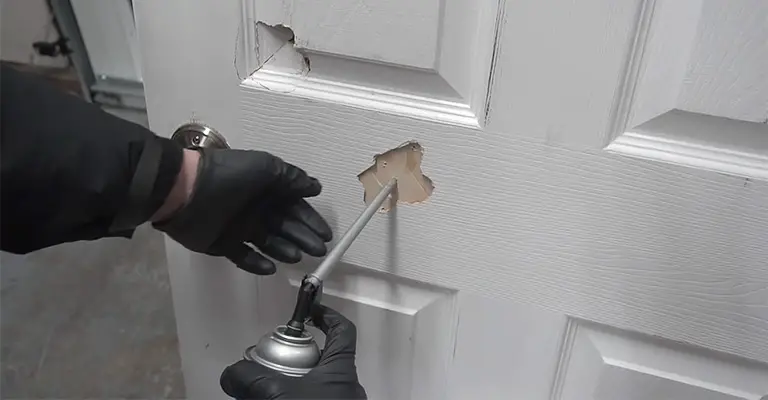
The door’s edges can be punctured with small holes to facilitate the application of foam, which should be allowed to expand and solidify from the lowest point of the door.
To minimize any potential issues, it is best to remove the door from its hinges and lay it flat before applying the foam.
- You can create small perforations along the door’s edges to facilitate the foam’s expansion and solidification. Removing the door from its hinges and laying it flat to avoid complications is recommended.
- Once the foam is applied, place a sheet of plywood on top of the door, and put a weight of approximately 100 pounds on it. This process will prevent any bulging caused by the foam, and it should be left for at least two days to set.
- When dealing with completely hollow doors, drilling from the top and applying the foam downwards is best. However, some “hollow” doors may still have a thin web of bracing inside that crisscross.
- To check if the door is completely hollow, drill two small holes of approximately 1/2 inch at the top end of the door. Shine a light down one hole while looking through the other.
- Remember that the foam expands upwards, so it is essential to ensure it falls all the way to the bottom of the door. Alternatively, you can remove the door and drill several holes down the hinge side to spray the foam in.
- If the door is hollow, you can apply foam, but be cautious not to use too much as it may cause the door to buckle. After letting the previous layer cure for a few hours, you can add more foam.
Note
We experimented with this technique at work to evaluate its effectiveness in reducing sound.
Since the door was to be replaced in an upcoming remodel with a larger opening, we weren’t concerned about any damage that might result from the process.
The results were satisfactory, but we achieved the best outcomes when we replaced the door with a solid wood one.
It’s important to note that the plugs created by drilling the holes may either fall inside the door or not fit back into the holes. Additionally, once the plugs are removed, the holes cannot be re-drilled to the same size.
I recommend replacing the doors with solid wood ones and ensuring that they are airtight sealed to achieve maximum results in reducing sound.
Wipe Away The Foam Mess Immediately
Although foam is effective, it can be messy, which is one of its disadvantages. If the foam expands beyond the intended area, you should know how to handle it.
Wiping the foam right away can worsen the mess as it spreads the foam. Instead, you can use a solvent to clean it up while it’s still wet. If the foam has already hardened, you can scrape it off.
Should You Use High Expanding Foam For Doors?
Expanding foam is popular for sealing gaps and cracks around doors and windows. However, using foam that expands significantly may push the door jamb inward, preventing the door from opening.
To avoid this issue, opting for foam with minimal expansion properties is advisable. Additionally, it’s important to use foam that is specifically designed for use on doors and windows.
Caution
It’s a common misconception that hollow core doors are entirely hollow. In reality, they usually contain a cardboard grid that is glued in place.
Additionally, it’s essential to note that expanding foam requires sufficient ambient air to react and expand. For instance, it’s not possible to fill a basketball with spray foam and expect it to transform from liquid to foam.
In construction, when filling unusual gaps, it’s essential to note that both ends of the foam can harden, leaving a soft interior void. However, in most cases, this is not a problem.
Another crucial factor to consider when using a two-part foam mix, which will undoubtedly expand when mixed, is the delicate nature of a hollow core door.
If the door is genuinely hollow, it’s advisable to lay it flat and place a weighted sheet of plywood or similar material on top of the door faces to keep them flat while the foam expands and cures.
This is necessary to avoid the foam pushing the face of the door outward, causing damage. As such, it’s crucial to be mindful of the appropriate method for using foam in various applications to achieve the desired results without causing any harm.
Final Words
Hollow interior doors are becoming popular for modern new homes due to their cost-effectiveness, lightweight nature, and resistance to warping, expansion, or contraction compared to solid wood doors.
If you consider insulating your hollow interior doors, doing it yourself can be more economical and convenient than hiring a professional.
To properly insulate your hollow interior doors, you can either attach or glue foam insulation sheets externally or fill the hollow interior door with spray foam by following the above steps.






